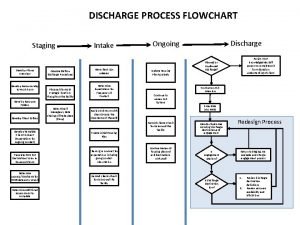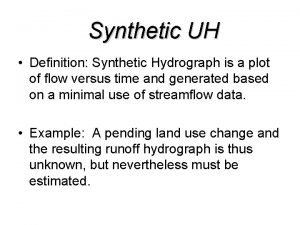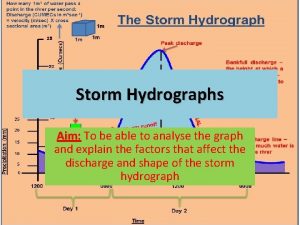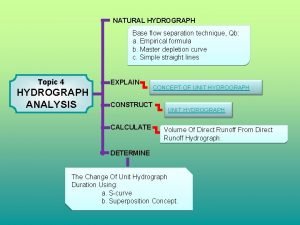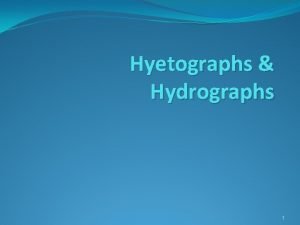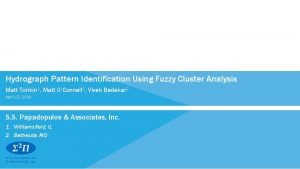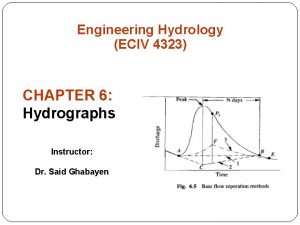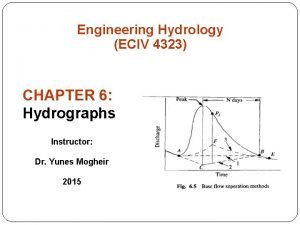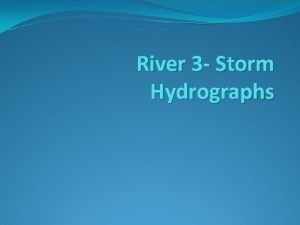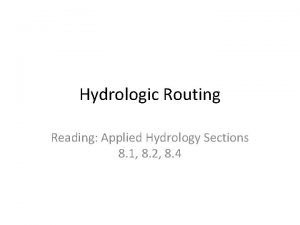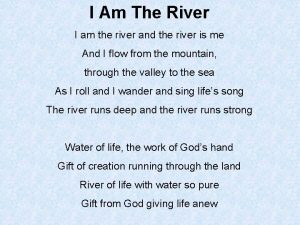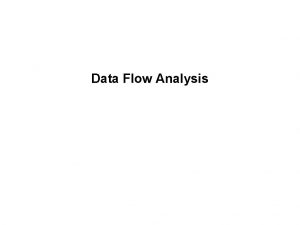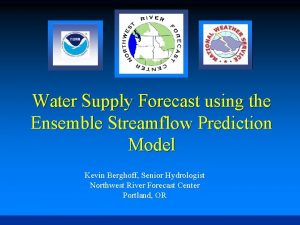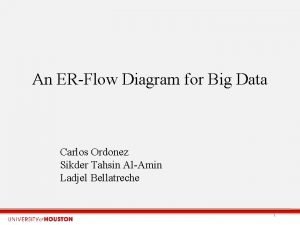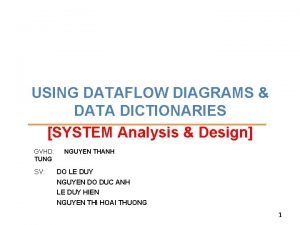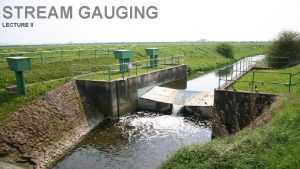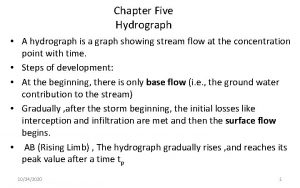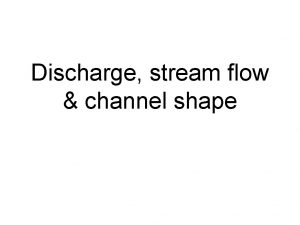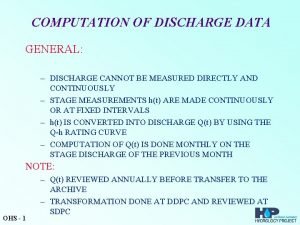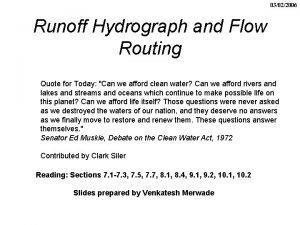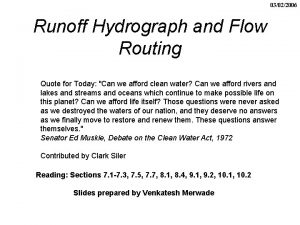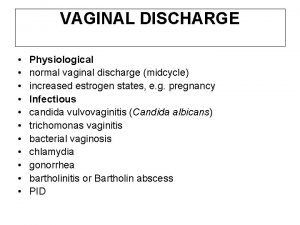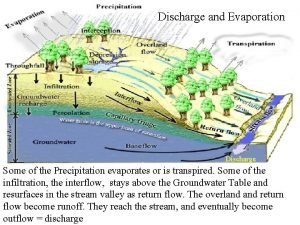HYDROGRAPH ANALYSIS River gauging produces discharge flow data


















































- Slides: 50

HYDROGRAPH ANALYSIS • River gauging produces discharge (flow) data of a crosssectional area of an outlet point of a watershed • Continuous recording of discharge data with respect to time will produce a discharge-time (Q-t) relationship of the watershed • Hydrograph—A record and graphical representation of discharge (Q) as a function of time (t) at a specific location, for example, the discharge at a point in a river or the discharge from a pumping well • Discharge of a river are fluctuated (up and down) due to the rainfall condition. How river response to rainfall. • The shape of hydrograph is depending on the shape of the watershed & the rainfall pattern PDT 379 Hydrograph Analysis 1

Effect of Watershed shape on Hydrograph shape A C B B A Q C t Different shape would produce different Tc PDT 379 Hydrograph Analysis 2

PDT 379 Hydrograph Analysis 3

PDT 379 Hydrograph Analysis 4

Natural Hydrograph • A natural hydrograph: An observed Q-t relationship of a watershed due to rainfall event • A rainfall event produces a single hydrograph • A natural hydrograph has Q(m 3/s) important characteristics: – Rising point (abrupt) (a) – Rising limb (b) a – Peak flow (c) – Falling limb (d) – Inflection point (e) c b d e Time (hr) PDT 379 Hydrograph Analysis 5

Hydrograph Record of River Discharge over a period of time River Discharge rivers mean = cross sectional area X (average) velocity (at a particular point in its course) Storm Hydrographs Show the change in discharge caused by a period of rainfall

Why Construct & Analyse Hydrographs ? To find out discharge patterns of a particular drainage basin Help predict flooding events, therefore influence implementation of flood prevention measures ©Microsoft Word clipart

Construction ©Microsoft Word clipart Of Storm (flood) Hydrographs

h p a r g o Rising limb b lim Through flow 4 1 ion mm Overland flow ss 2 ce Discharge (m 3/s) 3 Peak flow Re Fl d o o H r yd Basin lag time 3 2 0 Base flow 12 24 36 48 30 72 Hours from start of rain storm

Discharge (m 3/s) 3 2 1 0 12 24 36 48 30 72 Hours from start of rain storm

Rainfall shown in mm, as a bar graph Discharge (m 3/s) 3 2 mm 4 1 3 2 0 12 24 36 48 30 72 Hours from start of rain storm

Discharge in m 3/s, as a line graph Discharge (m 3/s) 3 2 mm 4 1 3 2 0 12 24 36 48 30 72 Hours from start of rain storm

Rising limb Rising Discharge (m 3/s) 3 The rising flood water in the river 2 mm 4 1 3 2 0 12 24 36 48 30 72 Hours from start of rain storm

Peak flow 36 30 limb Maximum discharge in the river Rising Discharge (m 3/s) 3 Peak flow 2 mm 4 1 3 2 0 12 24 48 72 Hours from start of rain storm

Recession limb Peak flow limb Falling flood water in the river n 2 sio Rising s ce Re lim mm b Discharge (m 3/s) 3 4 1 3 2 0 12 24 36 48 30 72 Hours from start of rain storm

Basin lag time limb ion ss Rising ce lim 2 Peak flow Re mm b Discharge (m 3/s) 3 Basin lag time 4 1 3 2 0 12 24 36 48 Time difference between the peak of the rain storm and the peak flow of the river 30 72 Hours from start of rain storm

Basin lag time limb Normal discharge of the river ion ss Rising ce lim 2 Peak flow Re mm b Discharge (m 3/s) 3 Base flow 4 1 3 2 0 Base flow 12 24 36 48 30 72 Hours from start of rain storm

Basin lag time limb = Storm Flow b lim Rising ion Overland flow ss mm Through flow 4 1 Through flow ce 2 + Peak flow Re Discharge (m 3/s) 3 Overland flow 3 2 0 Base flow 12 24 36 48 30 72 Hours from start of rain storm

Main Component of Hydrograph • Direct flow (quick flow, effective flow) (Qe)—That • • part of the flood hydrograph that represents the fastest response to rainfall and that is distinct from the base flow. Base flow (slow flow) (Qb)— That part of the stream discharge that is not attributable to direct runoff from rainfall or melting snow, it is usually sustained by groundwater. Basin lag (t. L) —The time difference between the centroids of rainfall excess and its corresponding peak surface runoff produced in the watershed Effective Rainfall, Pe i(mm/j) Indek t. L Qp Q(m 3/s) PDT 379 Hydrograph Analysis Qe Baseflow line Inflection point QQb b t(jam) 19

Base flow separation technique • • Natural hydrograph consists of two main components, i. e. Direct flow, Qe (quick flow) & Base flow (slow flow) (Qb). The quantity of Qe is important to know because it represents the volume flood and fresh water supply produced by individual rainfall Therefore it is important to separate the base flow from the total flow Various techniques. – Empirical formula: N = b A 0. 2 N • A = area (km 2) • b = constant = 0. 8, depending on watershed characteristics • N = time lag after Qp (day) – – Constant-discharge method Constant-slope Master Depletion Curve Digital filter for continuous hydrograph PDT 379 Hydrograph Analysis Qp Q(m 3/s) Titik infleksi t(jam) 20

PDT 379 Hydrograph Analysis 21

PDT 379 Hydrograph Analysis 22

Eg. Direct flow and base flow • 16 Estimate the volume of direct flow or fast flow (Qe) of a natural hydrograph with coordinate below if the watershed area is 100 Ha. What is the effective rainfall depth? (1) t (hr) (2) (3) Natural Hydrograph 14 12 10 Q (m 3/s) 8 6 (4) 4 2 Qt (m 3/s) Qb(m 3/s) Qe(m 3/s) 0 0 1 2 3 4 5 6 7 8 5 6 9 14 15 10 8 6 5 5 5 5 5 0 a. b. c. d. e. f. 5 Time (Hr) 10 Draw the natural hydrograph Separate its base flow Obtain the ordinate of the baseflow (Col 3) Obtain the ordinate of the Direct flow (Col 4) Calculate the total depth of direct flow Compute the total volume of direct flow PDT 379 Hydrograph Analysis 23

Eg. Direct flow and base flow • 16 Estimate the volume of direct flow or fast flow (Qe) of a natural hydrograph with coordinate below if the watershed area is 100 Ha. What is the effective rainfall depth? (1) t (hr) (2) (3) Natural Hydrograph 14 12 10 Q (m 3/s) 8 6 (4) 4 2 Qt (m 3/s) Qb(m 3/s) Qe(m 3/s) 0 0 1 2 3 4 5 6 7 8 5 6 9 14 15 10 8 6 5 5 5 5 5 0 1 4 9 10 5 3 1 0 0 a. b. c. d. e. f. 5 Time (Hr) 10 Draw the natural hydrograph Separate its base flow Obtain the ordinate of the baseflow (Col 3) Obtain the ordinate of the Direct flow (Col 4) Calculate the total depth of direct flow Compute the total volume of direct flow 33 PDT 379 Hydrograph Analysis 24

Natural Hydrograph 16 14 12 10 Q (m 3/s) 8 Baseflow Separation line Quick/fast/direct flow 6 4 Slow/base flow 2 0 0 2 4 6 8 10 Time (Hr) Total Volume of direct flow = Total surface area = ΣQe * dt = 33 m 3/s * 3600 s = 118 800 m 3 PDT 379 Hydrograph Analysis 26

A storm occurs over the Timah Tasoh Lake watershed. Measurements of rainfall and stream flow arelisted below. The drainage area, which contributes stream flow to the gage site is 1150 km 2. Determine the depth of run off. Day Hour Discharge (m 3/sec) Base Flow, Qb 22 0000 170 0600 150 1200 400 157 1800 750 165 0000 980 172 0600 890 180 1200 690 187 1800 480 195 0000 370 202 0600 300 210 1200 260 217 1800 225 0000 200 23 24 25 Analysis 180 0600 PDT 379 Hydrograph 180 1200 170 Direct Flow, Qe 27

Day Hour 22 23 24 25 Discharge (m 3/sec) Base Flow, Qb Direct Flow, Qe 0000 170 0 0600 150 0 1200 400 157 243 1800 750 165 585 0000 980 172 808 0600 890 180 710 1200 690 187 503 1800 480 195 285 0000 370 202 168 0600 300 210 90 1200 260 217 43 1800 225 0 0000 200 - 0600 180 - 1200 170 - PDT 379 Hydrograph Analysis Total : 3435 28

Depth = Σ Qe x time increment drainage area PDT 379 Hydrograph Analysis 29

Unit Hydrograph (UH) • Hydrograph of one unit surface runoff • Unit hydrograph—The discharge at a point, expressed as a function of time, due to a unit of effective rainfall that is applied uniformly over the contributing area during a specified period of time (D). • Hydrograph resulted from one unit of effective rainfall spread uniformly over the watershed for a given duration • Assumptions: – Effective rainfall is directly proportional to direct runoff • 2 Unit Effective rainfall will produce 2 unit hidrograph – Superposition: • 2 effective rainfall successively produce 2 successive UH with time lag T PDT 379 Hydrograph Analysis 30

Establishing UH from Natural Hydrograph 1. Obtain a natural hydrograph from a known effective rainfall (D) and duration (T) 2. Separate its base flow 3. Obtain the ordinate of the direct runoff 4. Compute the total volume (depth)of the direct runoff 5. Compute the ordinate of UH by dividing the ordinate of direct runoff to that the total depth of direct runoff 6. Plot UH having 3 important parameters, Peak flow(Qp), Time to peak (Tp), base time (Tb) PDT 379 Hydrograph Analysis 31

Eg: Unit Hydrograph Column (1) and (2) is the coordinate of a natural Hydrograph generated by 2 hour effective rainfall of 100 Ha watershed. Establish its Unit Hydrograph. 16 Natural Hydrograph 14 12 10 t (hr) 0 1 2 3 4 5 6 7 8 Qt (m 3/s) Qb(m 3/s) Qe(m 3/s) 5 6 9 14 15 10 8 6 5 5 5 5 5 0 1 4 9 10 5 3 1 0 Σ 33 m 3/s UH (m 3/s/cm) 0. 00 0. 08 0. 34 0. 76 0. 84 0. 42 0. 25 0. 08 0. 00 Q (m 3/s) 8 PDT 379 Hydrograph Analysis 6 4 2 0 0 5 Time (Hr) 10 32

Eg: Unit Hydrograph 1. 2. 3. 4. 5. 6. Effective rainfall duration, T=2 hr Separate its baseflow (column 3) Obtain ordinate of the effective hydrograph (Column 4) Compute total depth of runoff (11. 88 cm or 11. 88 unit) Compute the ordinate of UH by dividing the ordinate of direct runoff to that the total depth of direct runoff Plot UH having 3 important parameters, Peak flow(Qp), base time (Tb) 2 Hr-UH 0. 9 0. 8 0. 7 0. 6 0. 5 Q (m 3/s/cm) 0. 4 0. 3 0. 2 0. 1 0 0 PDT 379 Hydrograph Analysis 1 2 3 4 5 Time (hr) 6 7 33 8

Obtain a Unit Hydrograph for a basin of 315 km 2 of area using the rainfall and streamflow data tabulated below. PDT 379 Hydrograph Analysis 34

Step: 1. Calculate Qe 2. Obtain volume = Σ direct run off x time interval 3. Calculate rainfall depth 4. Calculate UH PDT 379 Hydrograph Analysis 35

PDT 379 Hydrograph Analysis 36

PDT 379 Hydrograph Analysis 37

Changing the duration of UH S-Curve method ü The established T-UH is not always applicable because of different duration of effective rainfall ü S-Curve: method of deriving a UH for a desired duration from one of another duration üEg: 2 Hr - UH to 3 Hr-UH ü Procedures: An S-curve is constructed from a series of UH of several T by the simple process of successive displacement by T and summing up the ordinates PDT 379 Hydrograph Analysis 38

PDT 379 Hydrograph Analysis 39

Eg: S-Curve method • • Convert the 2 Hr-UH in the previous example (page 10) to 3 Hr-UH, using S-Curve method Steps (refer to Table pg. 13): S-Curve – Obtain the ordinate of the original 2 Hr-UH (column 2) – Lagged the 2 Hr-UH ordinate for 2 hours several times (column 3, 4, 5, 6, …) – Summing-up all the ordinate (column 2+3+4+…. . ) to form Scurve ordinate (Column 6) – The plots of the lagged ordinates and S-curve is shown in Figure. PDT 379 Hydrograph Analysis 40

Eg: S-Curve method (cont. ) (1) (2) (3) (4) PDT 379 Hydrograph Analysis (5) (6) 41

Eg: S-Curve method (cont. ) • • • Steps (Cont. ) (Refer Table on the right) Obtain ordinate S-Curve (column 2) Lagged ordinate S-curve 3 Hrs (column 3) Subtract ordinate S-curve to 3 Hr lagged Curve (Column 4=column 2 - column 3) Obtain a new UH-3 Hr by multiplying column 4 with 2/3 (column 5) Plot the UH-2 Hr and UH-3 Hr in one graph to see the different ERT 246 - Ir Dr Ayob (2) (3) (4) (5) 42

2 Hr-UH to 3 Hr-UH 2 Hr-UH -Qp=1. 39 -Tb=7 Hrs 3 Hr-UH -Qp=1. 12 -Tb=8. 5 hrs ERT 246 - Ir Dr Ayob 43

Example 2 PDT 379 Hydrograph Analysis 44

PDT 379 Hydrograph Analysis 45

PDT 379 Hydrograph Analysis 46

Why multiply by a correction factor? • Here the original UH was for a 2 -hour storm, and we need a UH for a 3 -hour storm. • A 2 -hour UH is for a storm with 1/2 in/hr for 2 hours • A 3 -hour UH is for a storm with 1/3 in/hr for 3 hours • 1/2 x 2/3 = 1/3 • For each s-curves difference of lagged UHs , multiply the ordinates by D /D’ to get the correct UH

PDT 379 Hydrograph Analysis 48

Obtaining natural hydrograph from multiple rainfall from UH • Having UH, natural hydrograph from multiple rainfall (many rainfall) can be obtained • Eg. Using 1 Hr-UH, obtain natural hydrograph generated by 4 rainfall events as shown below ERT 246 - Ir Dr Ayob 49

multiple rainfall from UH ERT 246 - Ir Dr Ayob 50

4. 5 2. 5 1. 0 0 ERT 246 - Ir Dr Ayob 51
 Passaic river flood gauge
Passaic river flood gauge Hydrograph analysis
Hydrograph analysis River discharge
River discharge Job interview flowchart
Job interview flowchart Runoff volume
Runoff volume Unit hydrograph
Unit hydrograph What do hydrographs show
What do hydrographs show Natural hydrograph
Natural hydrograph Flashy and flat hydrograph
Flashy and flat hydrograph Unit hydrograph convolution
Unit hydrograph convolution Storm hydrograph
Storm hydrograph Hydrograph
Hydrograph Hair hydrograph
Hair hydrograph Drh in hydrology
Drh in hydrology The basic assumptions of the unit-hydrograph theory are
The basic assumptions of the unit-hydrograph theory are Drainage basin system
Drainage basin system Storm hydrograph definition
Storm hydrograph definition Outflow hydrograph
Outflow hydrograph Lumped flow routing
Lumped flow routing Data flow vs control flow
Data flow vs control flow Control flow and data flow computers
Control flow and data flow computers Green river (duwamish river tributary)
Green river (duwamish river tributary) I am the river and the river is me
I am the river and the river is me Ksao job analysis example
Ksao job analysis example Data flow diagram in system analysis and design
Data flow diagram in system analysis and design Global data flow analysis in compiler design
Global data flow analysis in compiler design What is data flow analysis in compiler design
What is data flow analysis in compiler design Available expression in compiler design
Available expression in compiler design Nwrfc water supply
Nwrfc water supply Where does the mekong river flow
Where does the mekong river flow River flow
River flow River flow map
River flow map Erflow
Erflow Data dictionary dfd
Data dictionary dfd Air to oxygen ratio chart
Air to oxygen ratio chart Cylinder oxygen
Cylinder oxygen O2 liters to fio2
O2 liters to fio2 Explain turbulent flow
Explain turbulent flow Internal and external flow
Internal and external flow Ecological succession
Ecological succession Flow of energy vs flow of matter
Flow of energy vs flow of matter Transform flow and transaction flow in software engineering
Transform flow and transaction flow in software engineering Data flow structure
Data flow structure Irrotational flow means *
Irrotational flow means * Internal versus external flow
Internal versus external flow Cheese making flow chart
Cheese making flow chart Transaction flow graph
Transaction flow graph Serosanguineous exudate
Serosanguineous exudate Yellow cottage cheese discharge
Yellow cottage cheese discharge Vagincal
Vagincal Bubble postpartum
Bubble postpartum



